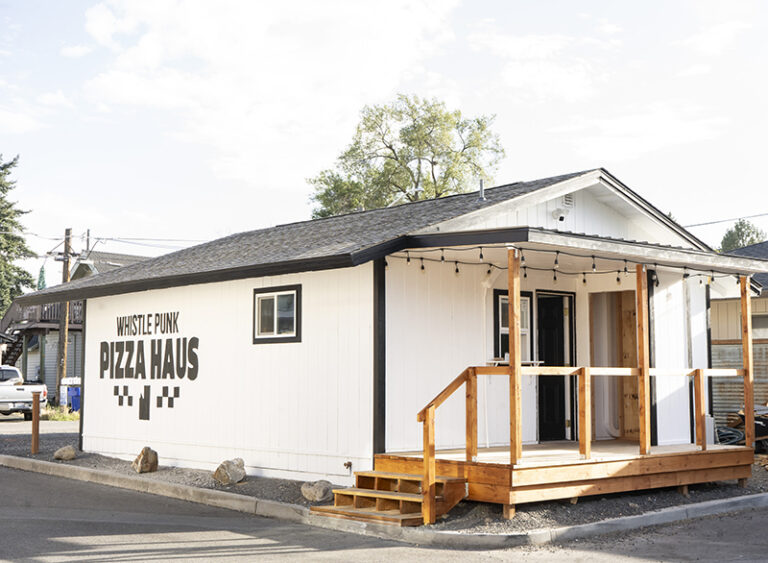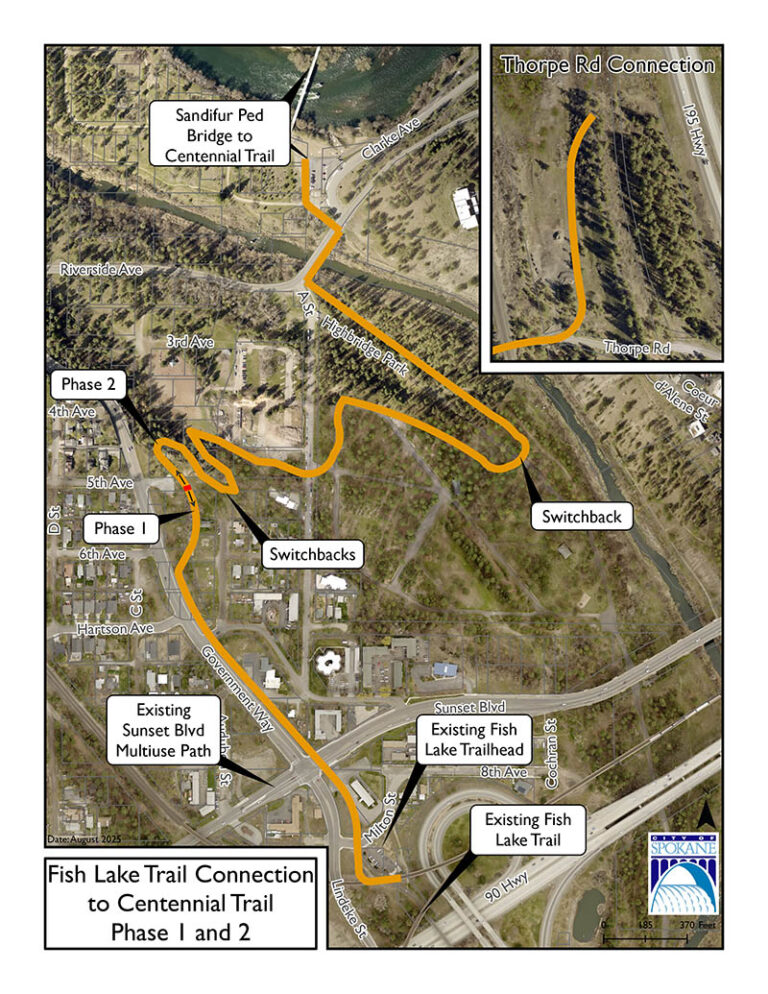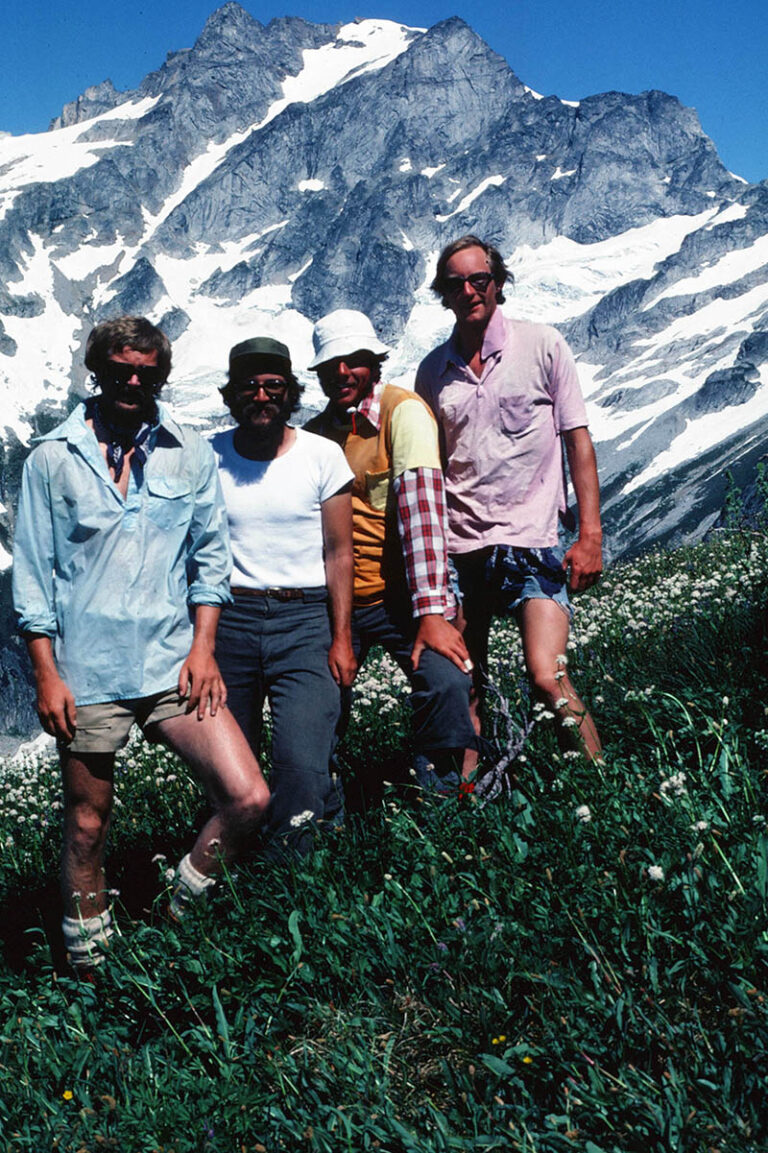Exploring winter magic in America’s first national park
By Jean Arthur
By the time my family and I finished snowshoeing around Mammoth Terraces in Yellowstone National Park, we’d tromped 1.5 miles, observed colorful formations like Orange Spring Mound and Angel Terrace, and laughed at our kids’ descriptions of the park’s famous thermal features exuding sulphureous belches.
“Eww. Dad. Do you have to do that here,” jokes my son, who’s well-versed in Yellowstone’s thermal world. The rotten-egg malodor derives from solfataras, hydrogen sulfide gas, chemical reactions where the pH below “1” can dissolve the soles of snowshoes, so acidic it is. Add heat, and Yellowstone provides habitat for thermoacidophiles—acid- and heat-loving microbes.
At Mammoth Terraces, the 200+ degree water dissolves limestone and forms glistening white calcium carbonate, travertine. Here, buffalo roam. Elk bugle. Bears sleep. Wolves howl. We adventure.
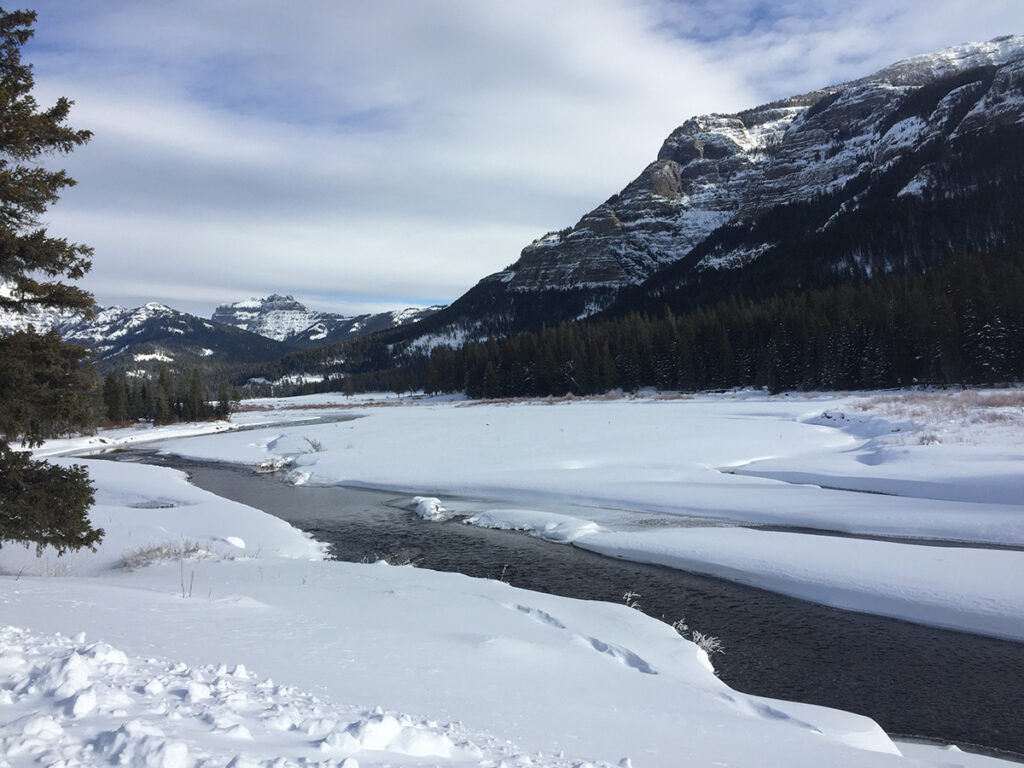
Back in the truck, parked along the Mammoth-to-Norris Road, the heater blasts, and our toes and noses defrost. The frigid mist from the evaporating thermal springs flock our mittens and hats with lovely crystals. Here at the Upper Terrace area, the road closes to automobiles for winter and opens to snowcoaches, over-the-snow tracked vehicles that shuttle visitors to backcountry trailheads and on to Old Faithful, our next trip.
Through the steam, we see a bull bison using his massive head to shovel snow aside as he searches for grasses in subnivean hibernation. While we worry that the 2,000-pound vegetarian might starve, we learn from the Visitor Center’s rangers that the ungulates, bison, elk, deer and pronghorn, evolved to survive on few calories in winter despite minus-20-degree days and even colder nights.
Elk wander the Lower Terrace area between the 37-foot-tall Liberty Cap formation, which resembles a torpedo—the kids add less savory descriptions—and the Mammoth Hot Spring Historic District. We tumble into the elegant Mammoth Hotel lobby where a roaring fire, pianist on the baby grand, and coffee shop warm hands and hearts. The hearty hot chocolate helps. Winter is a magical place for Yellowstone visitors.

Trail Etiquette and How to Explore the Park
Access to America’s first national park, established in 1872, includes a handful of snowshoe trailheads, one interior open road, and snowcoach routes, which are excellent options. Day excursions lead from cozy and elegant lodgings where après treks include crackling fires, hot or cold refreshments, and local lore.
The Gardiner and Mammoth area’s lodgings and libations offer an excellent launch for winter trips because the road from Gardiner, Mont., to Mammoth and on to Cooke City, Mont., is plowed. On other visits, we’ve skied and snowshoed the challenging 8-mile Blacktail Plateau Trail, the 2.5-mile easy Tower Falls out-and-back route, and the easy 3.5-mile Barronette Trail near Cooke City. Blacktail Plateau and Barronette trails have two trailheads and can be snowshoed one way if a group has a two-vehicle shuttle.
Trail etiquette includes giving right of way to the uphill traveler when encountering oncoming snowshoers, allowing speedier travelers to pass by stepping to trail’s side, and never snowshoeing on the skier track, which damages the trail for skiers. And, of course: leave no trace, only tracks.
Trails vary with challenges, from elevation (above 7,000 feet) to skill, wildlife hazards and limited daylight. (At winter solstice, sun sets just after 4 p.m.) Other than Gardiner lodgings, restaurants and outfitters; the Mammoth Hot Springs Hotel; and Mammoth General Store and Bear Den Ski Shop where we rented snowshoes, no services exist in winter for 50 miles. Eastward on the Grand Loop Road to the Northeast Entrance at Cooke City, lodgings, eateries and gift shops cater to winter visitors—mainly snowmobilers.
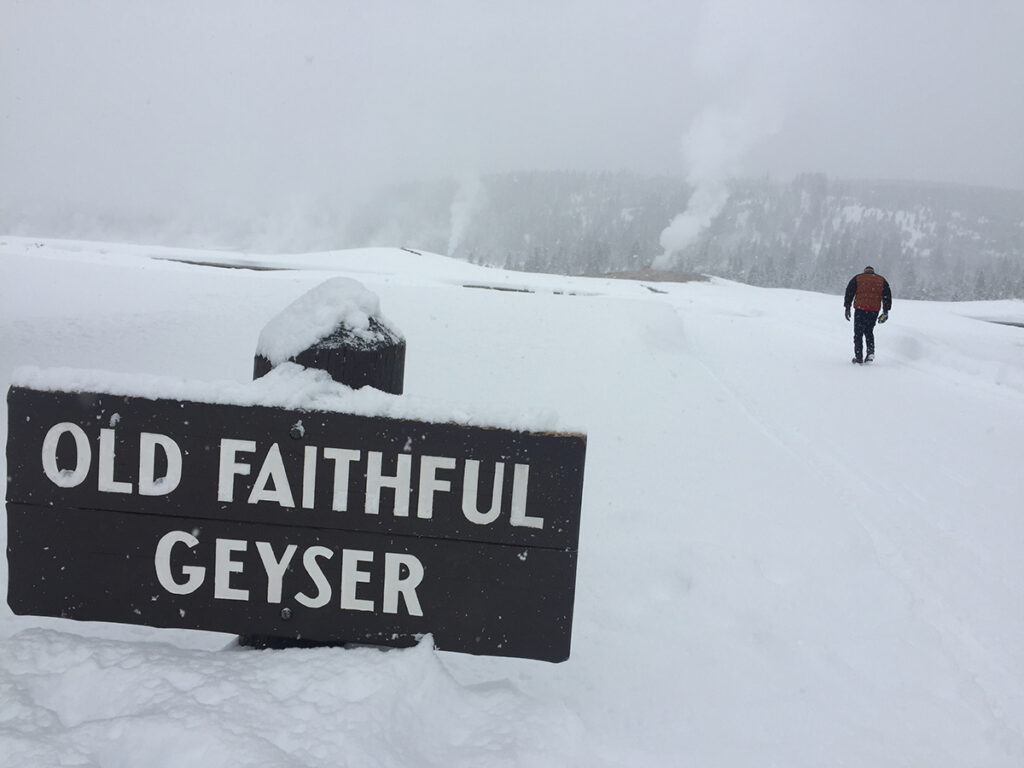
Visiting Old Faithful in Winter
Yellowstone is a curious place.
“Dad! I’ll race you to Old Faithful! Ready, set,” the kids dash ahead before my husband and I even think about trotting on snowshoes. On a spellbinding winter trip into the Old Faithful area, we ride a snowcoach from Mammoth, bumping over the snow-covered road, arriving four hours later at the world’s most famous geyser.
While several companies operate snowcoaches, we opt for the Yellowstone Park Lodges operator, which offers winter shuttles and interpreted and guided day tours to experience thermal features.
Sundogs dance their crystalline shimmer, just out of my reach, always just ahead of my family, who has left me in the powdery dust between our hotel, Old Faithful Snow Lodge, and the geyser, which rangers estimate will blast soon. Old Faithful, so named because regular eruptions gush every 35 to 120 minutes, attracts global visitors year round.
The Bear Den in Old Faithful Snow Lodge rents winter gear and sells whatever item, from hat to handwarmers, visitors neglected to bring—even ice skates for the pond outside the door. The Bear Den crew offers trail advice, guiding and even lessons.
After an excellent dinner at the lodge, we saunter out once again to witness a nighttime blast of Old Faithful by headlamp, nearly bumping into a herd of bison. We about-face and head back inside for live music and hot drinks by a roaring fire, satisfied that Old Faithful can wait til daylight. Our reward: wolves howl outside, much to visitors’—and our—delight.
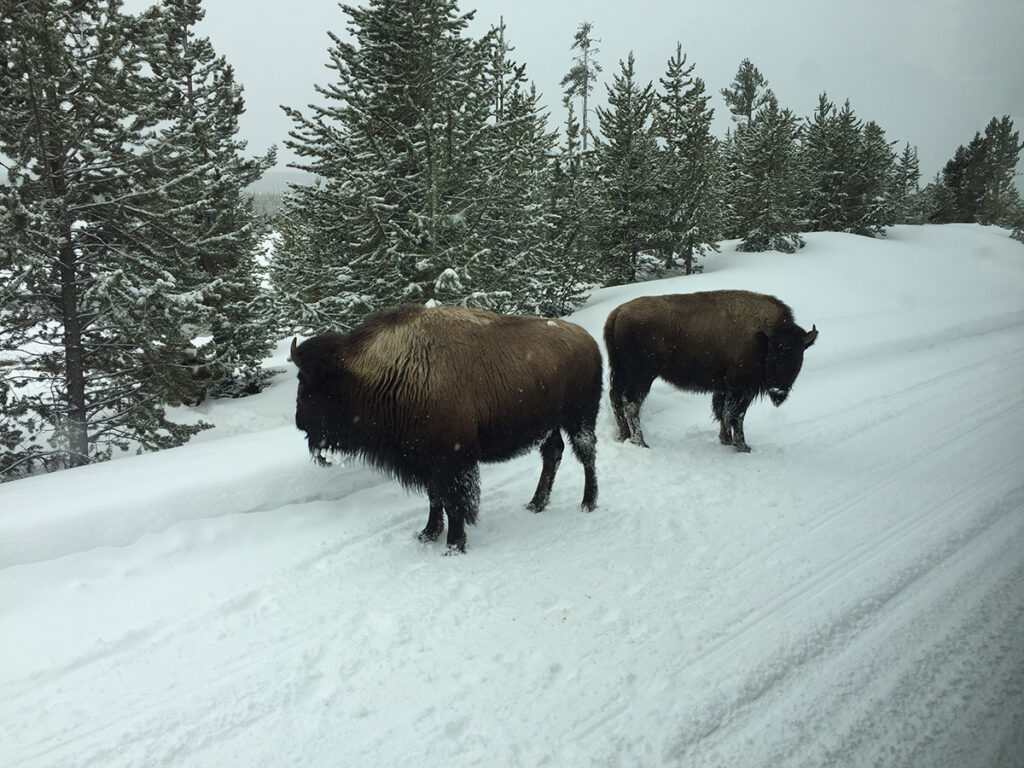
Recommended West Yellowstone Trails
On other trips, we’ve lodged and supped in West Yellowstone, Mont., where we would dip into the park from our hotel.
The gentle Riverside Ski Trail departs from Boundary Street trailhead on town’s east edge. The one-mile connector cruises eastward to the Madison River and the Downriver and Upriver Trail loops. A section of Downriver Loop, on the Madison River’s bank, tromps over Barnes Hole Rd., thus wide enough to snowshoe side-by-side and avoid the ski tracks. Snowshoers can spend as long as they want among the trees, Canada geese, occasional swans and bald eagles.
While the trail roams over small hills, it only gains a few feet elevation over the 7.7-mile trail, yet West Yellowstone’s elevation at 6,664 feet may challenge lungs and fitness. Trekkers may encounter bison, elk, owls and wolves, while the big carnivores, grizzly bears and black bears, mostly nap throughout the winters. Occasionally, male bears wander outside winter dens and groggily sniff around before returning to beds in a state of torpor and not true hibernation.
The trails here are not patrolled and seldom groomed. Skier and snowshoer tracks are easy to follow, but visitors should use an app such as onX, which offers trail information both online and offline. Spotty cellphone access available in communities is generally inaccessible inside the park.
Dazzled by the sundogs—hexagonal ice crystals that form a column of spinning ice mist—we thrive in winter’s solitude. The prism refracting the sun’s rays for diamond-like sparkles in the ten-degree morning is Yellowstone’s magic. Yellowstone National Park passes are required for all visitors (www.nps.gov/yell). Find additional regional tourism information at Visityellowstonecountry.com/. //
Jean Arthur has only written one adventure story from a chairlift, yet does snowshoe and XC ski from the door of her Montana office. The second edition of her book, Top Trails: Glacier National Park, will be published spring 2024 by Wilderness Press with new photography, new trails and lots of updates from both Glacier and Waterton National Parks.
Cover photo courtesy of Jean Arthur











